
Geopolitique 1990 by Bruce A. Ketchledge, published by SSI
First release : July 1983 on Apple II
Tested on : Applewin (Apple II) and Vice (C64) emulators
Total time tested : Around 10 hours
AAR : Part 1 [Peace], Part 2 [War]
Average duration of a campaign: 2 hours (diplomatic part) + 2 hours (war part)
Complexity: Average (2/5)
Would recommend to a modern player : No
Would recommend to a designer : No
Final Rating: Obsolete
Ranking at the time of review : 32/83
Summary :
The earliest Western Grand Strategy game I could find, Geopolitique 1990 amazes by its scope and its ambition for 1983, but not by its technical delivery (agonisingly slow BASIC) nor by the robustness of its design. Geopolitique 1990’s diplomatic module is original but deeply flawed and hard to steer, whereas its war module (not always used in a campaign) is more traditional and almost competently executed. It received critical acclaim in its time, but there is very little in its favour nowadays.
My rating and review posts usually start with a short bio of the author, but I could find very little about Bruce A. Ketchledge. Joel Billings does not remember him, and he left very little footprint online, except of course as the designer of the unimpressive Dnieper River Line. I could only find sporadic mentions of a Bruce [Arthur] Ketchledge (1948 – 1994), son of Raymond Ketchledge, who trained at MIT and worked in computers and/or software for Bell Laboratories. That’s all I have, and again it may be a totally different person.
Geopolitique 1990 received two versions : the initial July 1983 Apple II version which is the one I showcased, and a C64 port in Summer 1984. Uncharacteristically, the C64 version is a lot more than just a port and feels like a v2.0, with significant rebalancing both in the peace and the war modules – more details in the system section below. Both versions were sold for 39.95 USD, and for that price the box included one manual, two disks for the Apple II (only one for the Commodore 64) and two reference cards.
A. Immersion
Average. Provided you accept the result of the randomization of some scenarios (eg : Bolchevik Canada !), the game initially feels relatively immersive. Giving a name and a “motto” to the opposing politburo members makes the Soviet threat a lot more real!
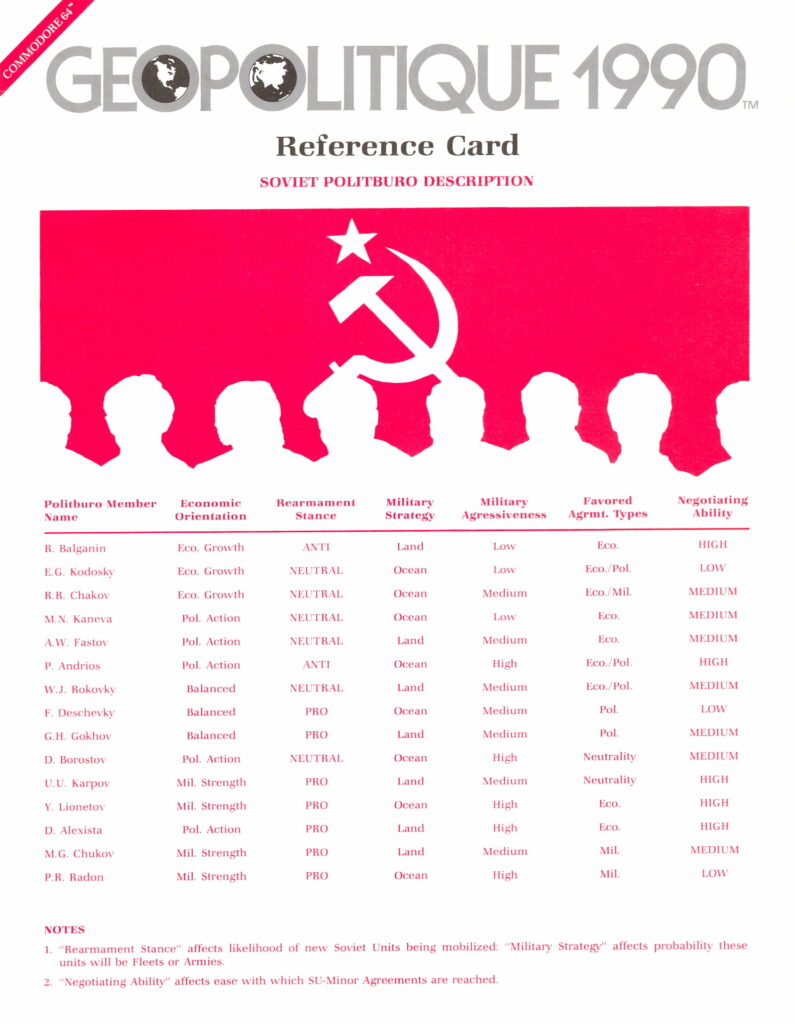
Alas, the diplomatic part of the game is too clunky, and the war part of the game too abstract to be really engaging. Extreme loading time and poor UI also makes everything a bit worse.
B. UI , Clarity of rules and outcomes
Terrible. Geopolitique 1990 takes some serious dedication to get into. In addition to its sluggish speed (BASIC in all its glory !), the game has a particularly dry manual, low tolerance for mistakes (you cannot roll back decisions, for instance if you allocated more industry to natural resources than you need) and, particularly in the war module, inconsistent UI that triggers game-changing mistakes.
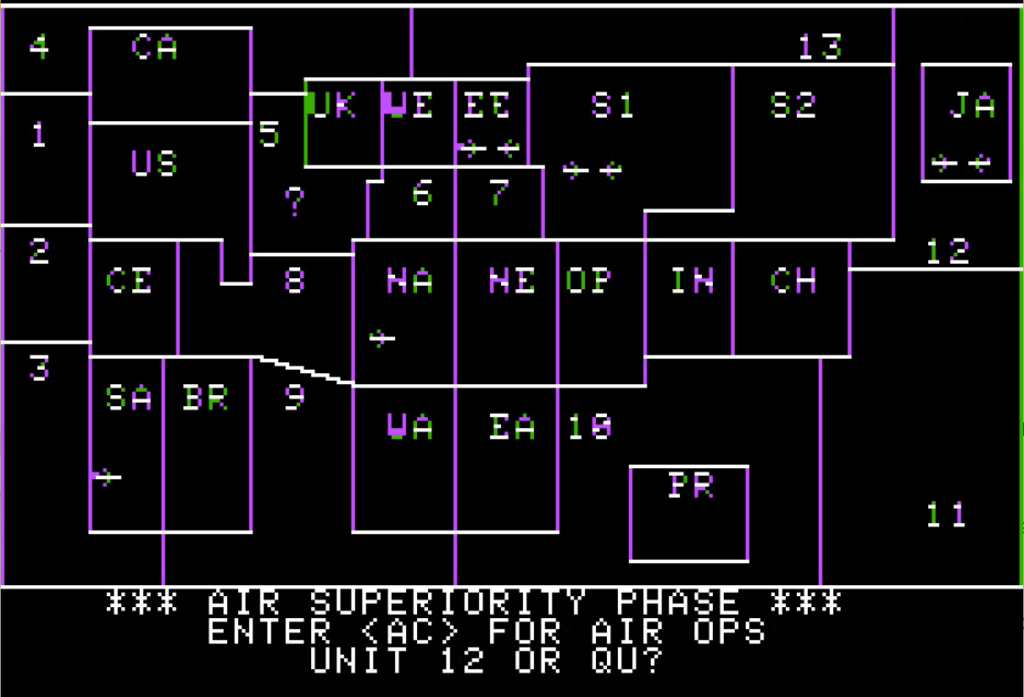
Even after you tame the UI, the outcome of whatever you do is hard to predict. Everyone seems so temperamental. The friendliest country in the world can suddenly go ballistic and call Moscow when you propose a political agreement, while a quasi-communist country may sign whatever paper you push in front of its eyes without even reading it.
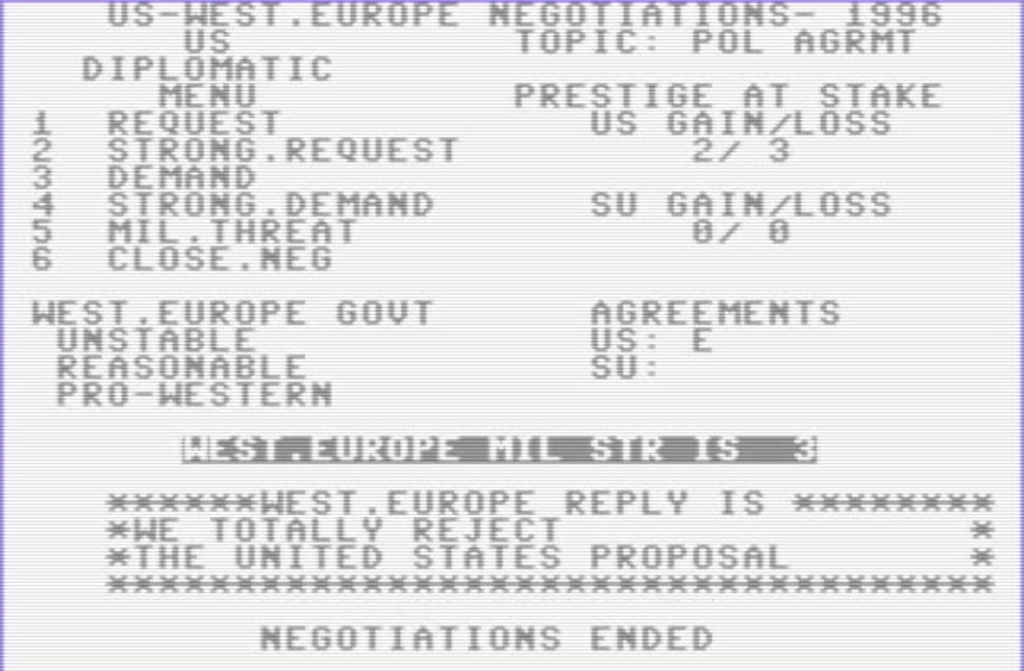
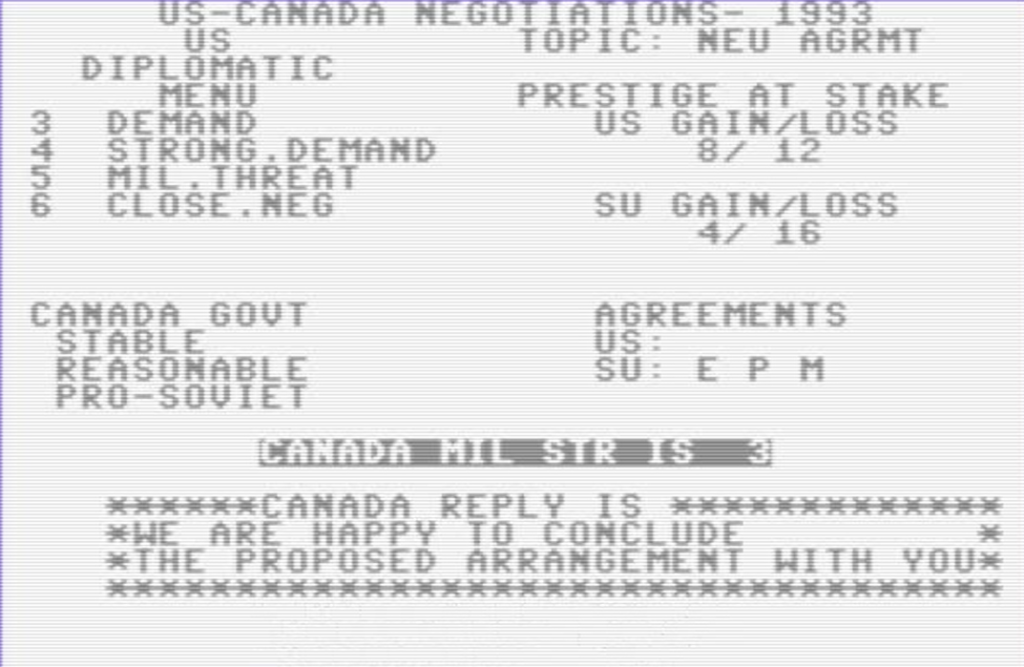
According to the manual, there is a right level of escalation between “request” and “military threat” (which ideally must be backed with action) but in my experience the random number generator rules supreme. And because “prestige” is lost faster than it is earned during negotiations, the lack of predictability really hurts the game.
The war module is a bit better from this point of view, though it still generates many unexpected results.
C. Systems
Poor. I explained the main loop at length in the AAR ; suffice to say here that both the peace and the war module mix good design with needlessly complicated design.
For the peace module, I liked having to balance economic growth, military growth and diplomacy, but I dislike some of those elements individually. The economic part is the worst. Imagine a shop that first asked you to split some of your $100 bills into smaller denominations, and then sell you its items for a specific number of $100 bills, $20 bills and $5 bills, but without letting you convert again. There is a good chance you would end up with some extra $100 bills because the last item you wanted cost five $20 bills. Well, that’s what happens in Geopolitique 1990, except replace the $100 bill by “Industrial Capacity” and the smaller denominations by the various “raw materials” in the game.
The game also fails on diplomacy. As stated earlier, it is hard to anticipate the AI’s behavior. The Soviet Union is also particularly sheepish, and the world tension level tends to die down. This creates an easy exploit : you can try to invade a reluctant country [an option theoretically available in both versions of the game, but not possible in my Apple II version due to a bug] every turn until it loses, and once it loses the country becomes pro-Western with the 3 possible agreements automatically signed.

As for the war module, it piles up features that individually work but don’t combine well. In particular, there is a weird system that seems pulled straight from boardgames where units under attack can’t themselves attack. This means that if you think the AI is going to attack you, you can attack first with any hapless unit you have available in the area, preventing the attack.
Apple II and Commodore 64 ruleset differences
As stated in the introduction, there are significant differences between the Apple II and the Commodore 64 versions, both in the peace and the war modules. I will mention the most impactful ones.
In the peace module :
- Armies are removed in the C64 version, the only military components are fleets that can be redeployed anywhere on the globe every turn.
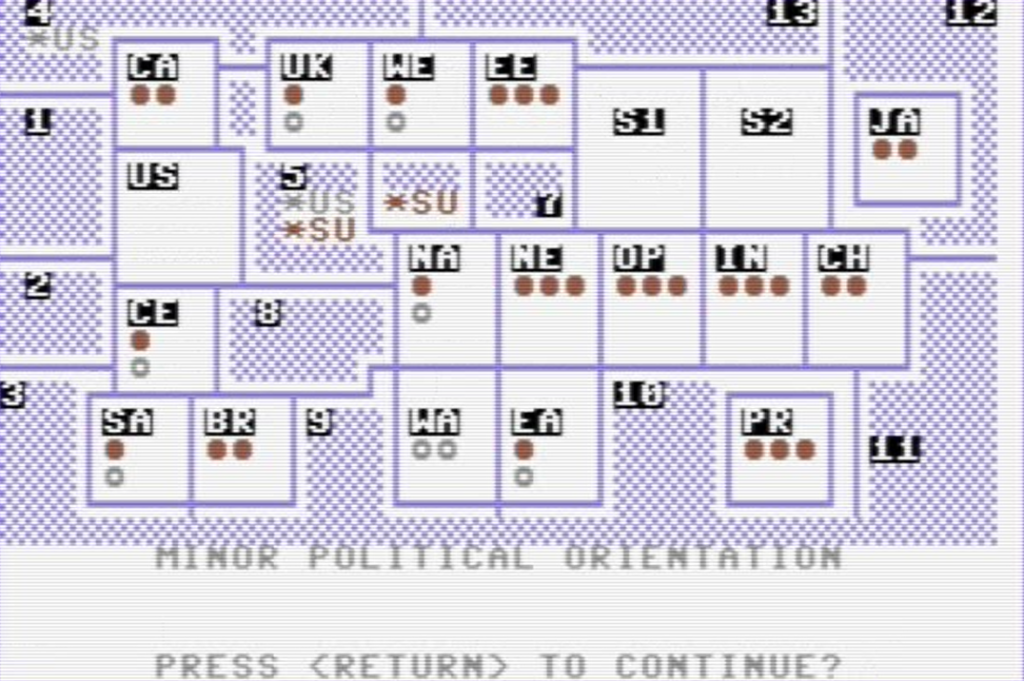
- There is no limit to how many fleets you can mobilize in a turn on C64 – but this is compensated by the price being effectively three times higher than in the Apple II version !
The more significant differences can be found in the war module :
- Fleets don’t start where they were positioned during peacetime, so it is not possible anymore to “prepare” for war like I did in my AAR,
- Countries siding with one faction or the other bring one army each,
- There is no mobilisation limit, so it is possible to churn 4 or 5 new units the first turn of the war.
- The war economy is simplified in Commodore 64 : there is only one currency (“resource points”), which is better distributed across the globe than industrial capacity. In peacetime, each region can bring between 0 and 12 [Japan] industrial capacity, whereas in wartime no region produces less than 3 or more than 10 resource points.
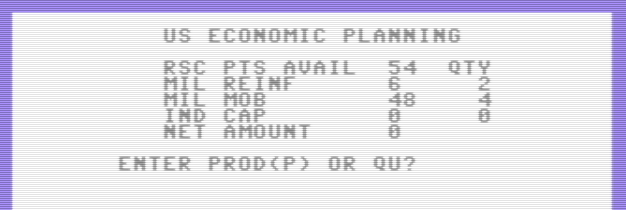
Both systems have their advantages. On Apple II, only a few regions really matter in the war module, with Canada a guaranteed turn 1 conquest and South America free VPs for the player, since Soviet Union will not start with any army there. On C64 the whole map is useful, but the war module lacks the early phase of the war where there are only a handful of units on the map and each of them is decisive. Overall, I think I prefer the C64 version : it is more challenging and to prepare for the war meaningfully you need to engage diplomatically with every country, and not only with Europe. The AI also copes better in the C64 version.
D. Scenario design & balancing
Fair. The game includes 7 scenarios, including one “contemporary” starting in 1984 with regions politically aligned as you would expect, and 6 scenarios either randomized or “prospective”. The scenarios start quite different, though in my experience the “random walk” of a typical game means that by the end of the campaign the political map is not recognizable in any way.
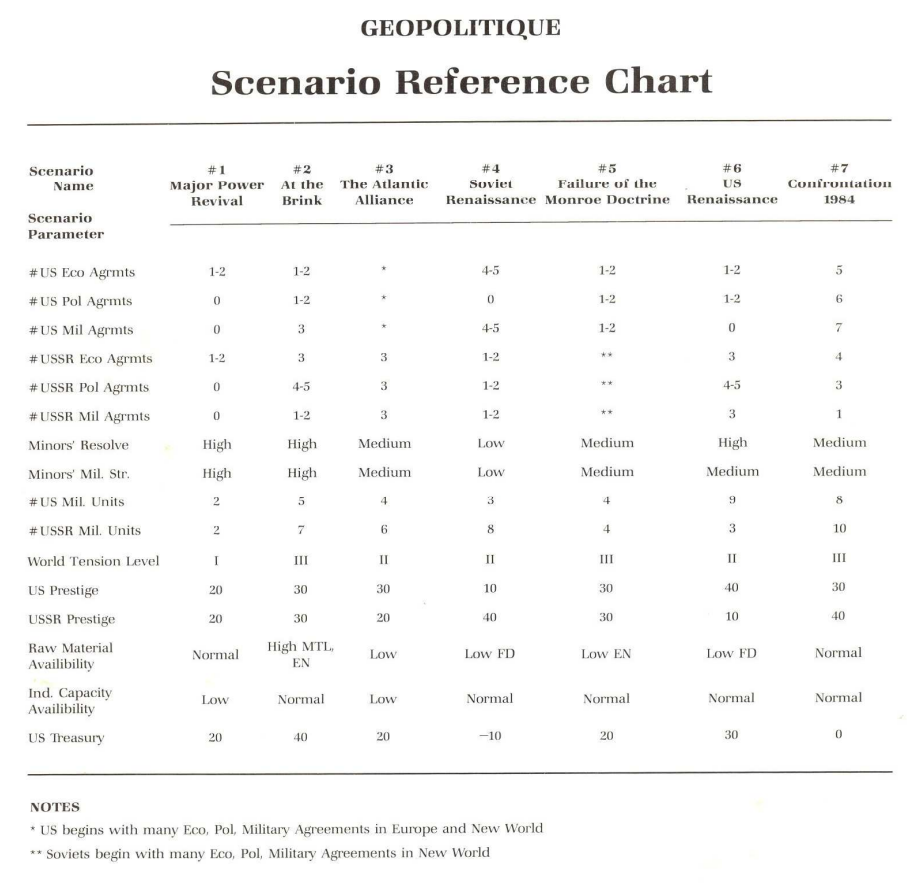
Whatever the scenario, the player can choose among 4 levels of difficulty and whether the priority should be prestige, GNP or military power.
In the peace module, the AI plays more or less according to the “mottos” and “stances” of its leaders. That’s nice, though mostly noticeable when the leaders are aligned on their strategy, else it just returns to the mean.
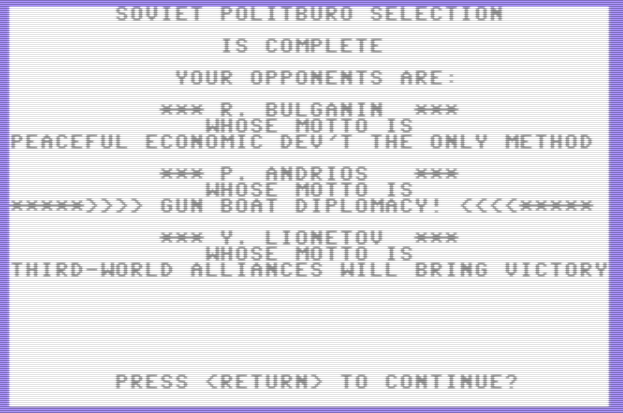
Lionetov : “No, we should negotiate a military agreement with North Africa”
Andrios: “What do you mean, “negotiate” ?
In the war module, the AI is weak, predictable and easy to beat.
E. Did I make interesting decisions ?
Yes : a few (resource allocation) in the peace module, a lot more in the war module
F. Final rating
Obsolete. Geopolitique 1990‘s scope and innovations could have made it a trailblazing game that passed the test of time, but its subpar UI, its convoluted economic model and its poorly thought-out diplomatic phase prevent it from really taking off. It is nonetheless the first real (not-Zendar) Grand Strategy game on the Western market. It is also I believe the first “double-layered” Western wargame (with the awkward and honestly unplayable exception of the Cosmic Balance I + II combo), even though the two layers are not “strategic” and “tactical” like in Nobunaga’s Ambition or so many other games that followed, but rather two different rulesets of “strategic”.
Contemporary Reviews
Geopolitique 1990 received critical acclaim, with most reviewers forgiving the game’s flaws given its ambition and innovation. A recurring complaint (3 different reviews !) was the simplification of the world map, for instance Jeff Seiken writing for Commodore Power Play in October 1985 :
No home computer game can adequately simulate all of the myriad complexities of modern day war and politics. Certain simplifications will have to be made and Geopolitique 1990 is no exception. Thus, only a few minor countries are represented on an individual basis and some regions consisting of nations with exceedingly diverse politics, like the Middle East, are lumped into single territories. The game also includes no ideological factors or influences, so countries like Canada and the United Kingdom are just as likely to conclude agreements with the Soviet Union as they are with the U.S.
Similarly, not everyone appreciated the look of the game or its speed. Still, all reviews concluded the game stood out for its time :
- Softline, November 1983 : “It’s fascinating gaming, even for people whose pleasure in war games has never graduated beyond Risk“
- Jeux & Stratégie, December 1983 “A simulation of an extraordinary quality“, Jeux & Stratégie put Geopolitique 1990 in October 1984 among the best 33 video games [all genres] on the market
- Computer Gaming World [Bob Proctor], February 1984 “Geopolitique 1990 is not only an excellent game, it is an innovative one.”
- Family Computing, October 1984 “Unanimously approved by play-testers serious enough to learn the rules, this is without question one of the most important game programs devised”
The only two reviews that were not completely sold were the aforementioned review in Commodore Power Play, which found the war part of the game “not as much fun as the political part” and the French Tilt which simply called the game “interesting” in its December 1986 review.
The game sold solidly with 10 000 copies in the USA. Despite its innovation and its success, Geopolitique was soon completely forgotten, replaced in collective memory by Chris Crawford’s Balance of Power (October 1985), which uses a somewhat similar design for the negotiations. Crawford never mentioned Geopolitique 1990 in his detailed narration about Balance of Power and it is clear he sourced his inspiration from other places. I played Balance of Power, and I can already say that Crawford’s game is a much better simulation of geopolitics – we will get to that when we reach 1985 – but Geopolitique 1990 is the first flawed but interesting effort to describe the contemporary world.